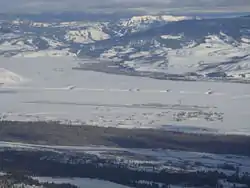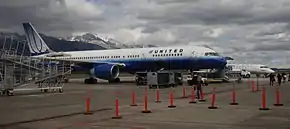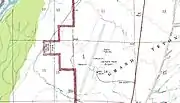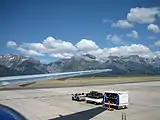Jackson Hole Airport
Jackson Hole Airport (IATA: JAC, ICAO: KJAC, FAA LID: JAC) is a United States public airport located seven miles (11 km) north of Jackson, in Teton County, Wyoming. In 2019, it was the busiest airport in Wyoming by passenger traffic with 455,000 passengers.[3] During peak seasons of Summer and winter, Jackson Hole has nonstop airline service from 19 destinations throughout the United States. The airport is served year-round by American Airlines, Alaska Airlines, Delta Air Lines, and United Airlines, and Alaska Airlines. The airport is served seasonally by Allegiant Air, and Sun Country airlines.
Jackson Hole Airport | |||||||||||
|---|---|---|---|---|---|---|---|---|---|---|---|
 | |||||||||||
| Summary | |||||||||||
| Airport type | Public | ||||||||||
| Owner | Jackson Hole Airport Board | ||||||||||
| Serves | Jackson Hole | ||||||||||
| Elevation AMSL | 6,451 ft / 1,966 m | ||||||||||
| Coordinates | 43°36′26″N 110°44′16″W | ||||||||||
| Website | www.JacksonHoleAirport.com | ||||||||||
| Map | |||||||||||
 JAC Location of airport in Wyoming / United States  JAC JAC (the United States) | |||||||||||
| Runways | |||||||||||
| |||||||||||
| Statistics (2017) | |||||||||||
| |||||||||||
Jackson Hole Airport is the only commercial airport in the United States located inside a national park, in this case Grand Teton.[4] (The Provincetown Municipal Airport in Massachusetts is on land leased from the National Park Service, but it is not in a national park.)
On November 6th, 2020, the airport announced an up to three-month closure in Spring 2022 for runway reconstruction.[5]
History
The airport was created in the 1930s as the best place to put an airport in Teton County. The airport was declared a national monument in 1943 and merged with Grand Teton National Park in 1950. The runway was extended to its current length in 1959. In the 1960s and 1970s a runway extension to 8,000 feet (2,400 m) to allow jets was considered; the National Park Service successfully opposed it. In the late 1970s jets began using the existing runway. The area is noise sensitive and the airport allows no jets louder than stage III. The airport is a popular mating ground for the rare sage grouse.[6]
Airlines that previously served Jackson Hole include Horizon Air, Western Airlines, Continental Airlines, Big Sky Airlines, Northwest Airlines and Southwest Airlines.
Facilities

Jackson Hole Airport covers 533 acres (216 ha); its one runway, 1/19, is 6,300 x 155 ft (1,920 x 47.2 m) asphalt.[2] Jackson Hole Airport is noise sensitive and bans older, noisier aircraft with stage-II engines.
Terminal History
The airport once had an unusual terminal resembling a pioneer log cabin. The terminal was completely rebuilt between 2009 and 2014. The new terminal, designed by Gensler,[7] still blends with the unique surroundings of the national park with exposed wood, fireplaces, and nature photography throughout. The park limited the height of the terminal building to 18 feet.[8] The terminal design received an American Institute of Architects Honor Award in 2014.
Current airport services
The airport currently has eleven hard stand gates and three baggage carousels. Jackson Hole Airport does not have jet bridges so passengers board aircraft via air-stairs. The airport terminal has Jedddiah's restaurant post security, as well as a gift shop, and a cafe by the airline ticket counter. The airport is served by Alamo, Hertz, Enterprise and National Rental car companies.
TSA
Jackson Hole Airport is one of 16 airports that uses private screeners under contract with the Transportation Security Administration's Screening Partnership Program. Security screeners are employed by the Jackson Hole Airport Board rather than the TSA.
Aircraft Information and restrictions
Due to the short runway and high altitude conditions that exist, The largest aircraft seen regularly is the Boeing 757-200 operated by Delta Air Lines. Other aircraft typically seen include the Airbus A319 and A320, Boeing 737-700, Embraer 175, and the Bombardier CRJ-700 regional jet. Due to these un fore seen conditions, Jackson Hole Airport does not typically see stretched versions of aircraft such as the Airbus A321 or Boeing 737-900ER, as they become weight restricted when taking off.
Airlines and destinations
| Airlines | Destinations |
|---|---|
| Alaska Airlines | San Diego, San Jose (CA) (ends February 6, 2021) Seattle |
| Allegiant Air | Seasonal: Las Vegas (begins June 4, 2021), Los Angeles (begins June 2, 2021), Phoenix-Mesa (begins June 2, 2021),< Reno/Tahoe (begins June 4, 2021) |
| American Airlines}} | Dallas/Fort Worth Seasonal: Charlotte Chicago–O'Hare, New York–LaGuardia |
| American Eagle | Seasonal: Los Angeles, Phoenix–Sky Harbor |
| Delta Air Lines | Salt Lake City Seasonal: Atlanta, Minneapolis/St. Paul |
| Delta Connection | Seasonal: Los Angeles, Salt Lake City |
| Sun Country Airlines | Seasonal: Minneapolis/St. Paul (begins May 26, 2021) |
| United Airlines | Denver,
Seasonal: Chicago–O'Hare, Houston–Intercontinental, Newark, Los Angeles |
| United Express | Denver Seasonal: Chicago–O'Hare Los Angeles, San Francisco |
| Destinations map |
|---|
 Jackson Destinations from Jackson Hole Airport (Red) = Year-round Destination (Green) = Seasonal Destination (Blue) = Future Destination |
Statistics
In the year ending December 31, 2018 the airport had 27,221 aircraft operations, average 75 per day: 42% general aviation, 30% air taxi, 27% airline and 1% military.[2] 21 aircraft at the time were based at the airport: 17 single-engine, 2 multi-engine, and 2 jet.[2]
Top destinations
| Rank | City | Passengers | Carriers |
|---|---|---|---|
| 1 | Denver, Colorado | 74,300 | United |
| 2 | Salt Lake City, Utah | 74,240 | Delta |
| 3 | Dallas/Fort Worth, Texas | 49,080 | American |
| 4 | Chicago–O'Hare, Illinois | 43,310 | American, United |
| 5 | Los Angeles, California | 11,190 | American, Delta, United |
| 6 | San Francisco, California | 8,860 | United |
| 7 | Atlanta, Georgia | 8,780 | Delta |
| 8 | Newark, New Jersey | 7,200 | United |
| 9 | Houston-Intercontinental, Texas | 3,450 | United |
| 10 | Minneapolis/St. Paul, Minnesota | 2,210 | Delta |
Accidents and incidents
- On August 17, 1996, a U.S. Air Force C-130 Hercules aircraft assigned to the 317th Airlift Group at Dyess AFB, Texas was unable to clear Sheep Mountain, crashing into it and killing all nine aboard. The aircraft was supporting the United States Secret Service as part of a POTUS visit to the area.[10]
- On December 20, 2000, actress and resident Sandra Bullock survived the crash of a chartered business jet at Jackson Hole Airport. The aircraft hit a snowbank instead of the runway, shearing off the nose gear and nose cone and damaging the wings.[11]
- On June 27, 2005, John T. Walton died when his CGS Hawk Arrow homebuilt aircraft (registered as an "experimental aircraft" under FAA regulations) that he was piloting crashed in Jackson, Wyoming. Walton's plane crashed at 12:20 p.m. local time (1820 GMT) shortly after taking off from Jackson Hole Airport.[12]
- On December 29, 2010, An American Airlines Boeing 757 Flight 2253 from Chicago–O'Hare overran the runway. There were no injuries.[13]
Gallery
 Aerial photo of airport
Aerial photo of airport Map showing the airport
Map showing the airport Closeup of airport map
Closeup of airport map View of the Tetons from the ramp
View of the Tetons from the ramp An American A319 approaching the airport with the Teton range in view
An American A319 approaching the airport with the Teton range in view
References
- Jackson Hole Airport, official web site
- FAA Airport Form 5010 for JAC PDF, effective 2010-11-18
- "After another record year, airport forecasts slower growth". Jackson Hole News & Guide.
- Jackson Hole Airport web site. Retrieved February 19, 2019.
- https://www.jacksonholeairport.com/2020/11/jh-airport-press-release-jh-airport-board-announces-runway-reconstruction-and-related-projects-for-the-spring-of-2022/
- "Airport Administration - Jackson Hole Airport (JAC), Jackson Hole, Wyoming".
- "Jackson Hole Airport Terminal Expansion / Gensler". Architecture Lab. Archived from the original on 2011-10-01.
- "Jackson Hole Airport". APA – The Engineered Wood Association. Retrieved 26 October 2016.
- http://www.transtats.bts.gov/airports.asp?pn=1&Airport=JAC&Airport_Name=Jackson, WY: Jackson Hole&carrier=FACTS
- Jones II, Roy A. (18 August 1996). "Dyess C-130 crashes; no survivors". Abilene Reporter-News. Archived from the original on 14 June 2011. Retrieved 22 January 2011.
- "Plane Crash Involving Actress Sandra Bullock". AirSafe.com. 16 November 2007. Retrieved 22 January 2011.
- "DEN05FA100". NTSB. 31 October 2006. Retrieved 22 January 2011.
- "American Airlines Flight 2253". Aviation Week. 6 June 2012. Retrieved 6 June 2012.
External links
- FAA Airport Diagram (PDF), effective January 28, 2021
- Resources for this airport:
- FAA airport information for JAC
- AirNav airport information for KJAC
- ASN accident history for JAC
- FlightAware airport information and live flight tracker
- NOAA/NWS weather observations: current, past three days
- SkyVector aeronautical chart, Terminal Procedures
